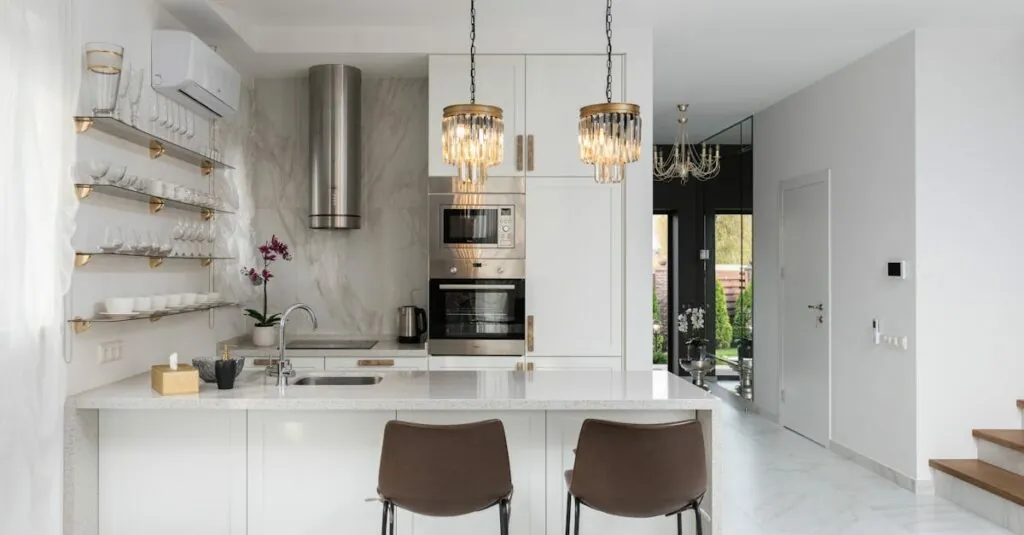Table of Contents
ToggleImagine walking into your home and having the lights greet you like a loyal puppy. Smart home lighting installation isn’t just about convenience; it’s about transforming your living space into a futuristic haven. With a flick of your finger or a simple voice command, you can set the perfect mood for movie night or create a dazzling ambiance for entertaining guests.
Overview of Smart Home Lighting Installation
Smart home lighting installation simplifies everyday living. This technology offers seamless integration with existing home systems, enhancing control over illumination. Users can adjust brightness and color temperature through apps, switches, or voice commands, making lighting adjustments effortless.
Smart lighting systems often connect to Wi-Fi, allowing remote access. With a smart hub, managing multiple devices becomes simple. Sensors can also detect occupancy, automatically adjusting lights to save energy. This feature not only increases convenience but also promotes sustainability.
Different smart bulbs provide versatility for various settings. LED smart bulbs, for example, consume less energy while offering customizable colors. Dimming options contribute to creating the perfect ambiance for any occasion. For instance, soft, warm tones can enhance a cozy movie night at home.
Installation steps vary based on the chosen system. Many products simply require replacing existing bulbs, while others may need hardwiring. Consulting the user manual ensures the correct setup. Additional components, such as smart switches or connectors, can expand functionality.
Security features enhance smart lighting installations. Users can set schedules for lights to mimic occupancy when they’re away. This automatically activated lighting deters potential intruders, adding an extra layer of safety.
Incorporating smart home lighting elevates both practicality and style. With ongoing advancements, these systems continuously evolve to meet user needs. Adapting to personal preferences creates customized environments, elevating everyday experiences.
Benefits of Smart Home Lighting
Smart home lighting installation offers numerous advantages that enhance everyday living. Users experience increased convenience and improved ambiance throughout their homes.
Energy Efficiency
Energy-efficient smart bulbs use significantly less power than traditional incandescent options. LED technology consumes up to 80% less energy, contributing to lower electricity bills. Smart lighting systems allow users to schedule lights to turn off automatically, ensuring no energy is wasted. Furthermore, occupancy sensors detect when rooms are unoccupied and adjust lighting accordingly. This capability leads to substantial savings over time, making it an environmentally friendly choice.
Enhanced Security
Smart home lighting enhances security by simulating an occupied home. Users can schedule lights to turn on and off at various times, creating the illusion of presence. This feature deters potential intruders. Advanced systems can also integrate with security cameras and alarms for a comprehensive security solution. Remote access through smartphone apps allows users to control lights while away, providing peace of mind. Combined, these features significantly increase home security.
Types of Smart Home Lighting
Smart home lighting comes in various forms, each offering unique features and benefits to enhance the living environment. Key types include smart bulbs and smart switches.
Smart Bulbs
Smart bulbs represent an easy entry point into smart home lighting. These energy-efficient LED options allow users to change colors and brightness levels through mobile apps or voice commands. Many smart bulbs feature built-in scheduling and automation, enabling lights to turn on and off at specific times. Options like Phillips Hue and LIFX offer vast color selections to match any mood or occasion. Smart bulbs also integrate seamlessly with existing fixtures, simplifying installation and setup. With the ability to adjust settings remotely, users enjoy flexibility in creating personalized lighting at their fingertips.
Smart Switches
Smart switches offer more permanent solutions for controlling lighting. Unlike smart bulbs, these devices replace existing wall switches, providing control over multiple lights at once. Many smart switches support voice control and can connect to smart home ecosystems like Amazon Alexa or Google Assistant. Users can schedule lights or create ambiance with scene settings. Switch types vary, including dimmer switches, which allow for adjusting brightness levels, and three-way switches that control lights from multiple locations. Installing smart switches improves overall functionality by giving users centralized control over their home’s lighting system.
Installation Process
The installation process for smart home lighting involves several essential steps to ensure optimal functionality.
Required Tools and Materials
He’ll need a few tools and materials for installation. Gather a screwdriver, wire stripper, and pliers for basic electrical work. Purchase smart bulbs or switches that fit specific needs. Ensure access to a compatible smartphone or tablet for setup. Additionally, consider having a ladder on hand for high placements or hard-to-reach areas. Ensure Wi-Fi connectivity for seamless operation, and a reliable app for controlling the system post-installation will enhance user experience.
Step-by-Step Guide
Begin by turning off the power at the circuit breaker. Remove existing light fixtures or bulbs, and safely disconnect wiring if necessary. Install smart bulbs by screwing them in place or replace standard switches with smart switches according to manufacturer instructions. Connect devices to Wi-Fi via the corresponding app on a smartphone. Follow the app’s prompts to finalize setup, ensuring all functionality aligns with user preferences. Test the system to confirm proper operation and adjust settings to create the desired ambiance.
Challenges and Considerations
Smart home lighting installation presents various challenges that require careful consideration to ensure optimal performance and user satisfaction.
Compatibility Issues
Compatibility remains a critical factor in smart home lighting. Various smart lighting products may not work seamlessly with existing home systems. Ensure smart bulbs or switches are compatible with the current hub or ecosystem, whether it’s Google Home, Amazon Alexa, or Apple HomeKit. The operating systems of devices may vary, affecting functionality. Verify that chosen products integrate smoothly with users’ Wi-Fi networks and other smart devices before proceeding with installation. Mismatched technologies can lead to connection problems, limiting features and usage.
Cost Factors
Cost significantly influences smart home lighting installation decisions. Initial setup expenses for smart bulbs, switches, and accessories can vary greatly based on brand and technology. On average, smart LEDs range from $10 to $30 per bulb, while smart switches may cost between $30 and $60. Additional costs come from installation services if users opt out of DIY. Budget considerations also include potential energy savings from using energy-efficient bulbs, with LED options consuming 80% less power than traditional types. Assessing both upfront and long-term costs ensures users make informed choices.
Smart home lighting installation offers a blend of convenience and energy efficiency that transforms everyday living. By integrating advanced technologies users can enjoy customizable lighting that enhances their home environment while reducing energy costs. The ability to control lighting through apps or voice commands not only simplifies daily routines but also adds an element of security.
As users explore their options whether opting for smart bulbs or switches they’ll find that the benefits extend beyond aesthetics. Investing in smart lighting systems is a step toward a more connected and efficient home. With careful consideration of compatibility and costs users can create an ambiance that perfectly suits their lifestyle.







